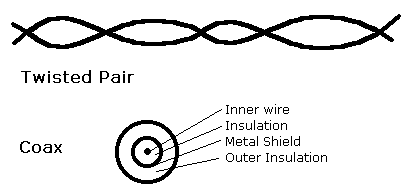Data Transmission
Unit Goals
Physical Transmission Media
Recall that nodes are devices such as computers, printers, routers, terminals, mobile devices, copiers, vending machines, speakers, and household appliances. The data is carried between node via connections such as wires, glass fiber, radio, infrared, microwave, staellite, laser. What are some characteristics of the different transmission media?
Wire
Copper is the nearly universal choice for a wire since it is a good conductor, but there is a potential for interference, which is usually solved either by using twisted pairs or coax.

Glass fiber
You can also use media not subject to interference.

- No electrical interference (won’t cause it, won’t be susceptible to it)
- Pulse of light can be carried farther than a signal in a wire (repeaters very far apart)
- Very high speed, even 100s of Gbps
- Light can encode more information than electricity
- Single fiber is okay, you don’t need a circuit!
- Low error rate
- Expensive to manufacture
- May be hard to detect the location of a break
- Expensive to repair a break
- No need to worry about electromagnetic noise
Radio
Radio is an unguided media: no physical wire, no physical connections.
- Uses RF antennas to carry electromagnetic signals
- Subject to reflection, obstruction (those darn mountains), interference
- Used in Wi-fi LANs (11–54Mbps) and Cellular WANs
Microwave
Also unguided. Differs from radio in that:
- Can be beamed in a given direction (unlike radio)
- Can’t penetrate metal or even some vegetation, need TALL antennas
Infrared
I’m not too familiar with these. I’ve heard:
- The technology is confined pretty much to a single room
- No antenna is needed
Satellite
Similar to RF. Transponders used to amplify signal. A single satellite will often have multiple transponders and share channels too. Up to around 45Mbps tops. Has noticeable end-to-end delay (270ms). Kinds of satellites:
- Geosynchronous: high earth orbit, 22,236 miles up over equator. Limited space in this orbit, since you need 4 to 8 degrees of separation to avoid serious interference.
- Low-earth-orbit: generally just a few hundred miles up so they orbit in 90 minutes or so.
- Low-earth-orbit-satellite-arrays: refers to placing a whole bunch of LEO satellites up there so you always have one near you at any time.
Laser
Pretty similar, feature-wise, to microwave communication.
Speed
What’s the maximum (stated) rate that bits can actually flow through certain media? (There is a table at WhatIs.com that I grabbed some of this information from.)
| Medium | Max bit rate |
|---|---|
| Analog Modems | 56 Kbps |
| ISDN Phone Line | 128 Kbps |
| AppleTalk | 230.4 Kbps |
| Satellite | 400 Kbps |
| Frame Relay | 1.544 Mbps |
| T1 | 1.544 Mbps |
| IBM Token Ring | 4 Mbps, 16Mbps |
| DSL Phone Line | 6 Mbps |
| (Plain) Ethernet | 10 Mbps |
| T3 | 44.736 Mbps |
| OC-1 | 51.84 Mbps |
| Cable Modem | 52 Mbps |
| Fast Ethernet | 100 Mbps |
| OC3/STM1 | 155.52 Mbps |
| OC12 | 622.08 Mbps |
| Gigabit Ethernet | 1 Gbps |
| OC48/STM16 | 2.488 Gbps |
| OC192/STM64 | 10 Gbps |
| OC256 | 13.271 Gbps |
How useful is this data anyway?
The speed of a line doesn’t mean you actually get data at this rate. For example a line may be shared, like in a Cable Modem so you may only be getting, say, 1 MB/sec to your modem. Then the data has to go to your network card where it is processed and shoved to your memory, which may be slow! Also the actual data you are downloading is only part of what is traveling though the net, as you are getting a lot of packets with a lot of header and checksum information, that must be stripped and processed, taking even more time. And some setup are such that upstream data rates might be much slower.
Local vs. Long Distance Communication
Some technologies are way better for local communication and some are better for long distance. Local communication:
- Can be done by sampling voltages on the media
- Considers time between samples, detecting the beginning of a frame, and detecting the end of the frame, as part of a protocol
Long distance communication, on the other hand:
- Requires carrier waves (example encodings: AM, FM, Phase-shift modulation)
- Needs modems at both ends
- Requires multiplexing, generally
Summary
We’ve covered:
- Various ways that data can be transmitted
- Theoretical maximum throughput for different technologies
- The difference between local and long distance communication